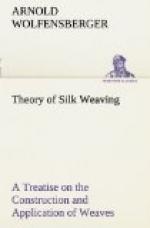In the foundation weaves each thread effects only
one crossing in one repeat of the weave, and the points
of interlacing occur in a given rotation. A repeat
in the foundation weaves comprises the same number
of warp-threads as of picks or filling threads,
and if this number is 8, for
[Page
16]
instance, the weave is called an 8-shaft or an 8-harness
weave. In marking out a weave, the warp-threads
are represented by vertical lines, the filling by
horizontal ones, or in each case by the space between
these lines. The places where a warp-thread lies
over the filling are marked with paint or simply with
a cross. In a similar manner we mark out the chain
draft, which indicates the rotation in which the
shafts are raised.
* * * * *
[Page
17]
THE TAFFETA WEAVE
[Illustration: Fig. 16]
* * * *
[Illustration: Fig. 17]
[Page 18]This is the simplest and oldest method of interlacing. The odd numbers of warp-threads cross the even numbers after every pick; hence of two warp-threads one will always go over the first pick and under the second, and the other end under the first and over the second pick. Taffeta cloth, therefore, has the same appearance on both sides, and in cotton and wool weaving this weave is technically—and properly indeed—called the Plain Weave. It has the smallest repeat, 2 warp-threads and 2 picks, and the exchanging of warp and filling is the most frequent possible. The cloth thus produced is firmer and stronger than that obtained with any other weave.
Fig. 16 is a taffeta on 4 shafts straight draw, the draft executed in the manner which we have already mentioned in explaining the drawing-in drafts.
Fig. 17 on common designing paper, illustrates a taffeta made on 8-harness, skip draw.
Be it mentioned that the drawing-in draft and the chain draft will be added throughout this work, the former over the weave to correspond with the respective warp-threads, the latter to the right of the drawing-in draft.
* * * * *
[Page 19] GROS DE TOURS WEAVES
[Illustration: Fig. 18]
* * * *
[Illustration: Fig. 19]
In this weave the working of the warp is the same as in taffeta, except that instead of one pick, two or more are inserted in the same shed. It is mostly used in selvedges, where it serves to give more firmness to the edge of an otherwise loosely woven cloth, and prevents the weaving ahead of the edge in a tight weave. Gros de Tours is sometimes used, especially when cotton or wool filling is employed, with a view to lay two picks nicely side by side, whereas a thread entered two ply with the taffeta weave will always receive some twist, which may disturb the perfect evenness of the fabric.




